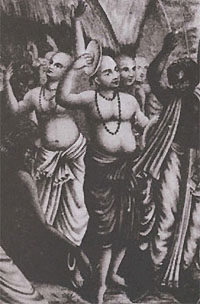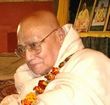 Mahaprabhu's seniors, His parents and gurus, are all his servants and eternal associates and they take their birth prior to His appearance in order to serve Him in their own way.
Mahaprabhu's seniors, His parents and gurus, are all his servants and eternal associates and they take their birth prior to His appearance in order to serve Him in their own way.
 Mahaprabhu's seniors, His parents and gurus, are all his servants and eternal associates and they take their birth prior to His appearance in order to serve Him in their own way.
Mahaprabhu's seniors, His parents and gurus, are all his servants and eternal associates and they take their birth prior to His appearance in order to serve Him in their own way.
Whenever Krishna descends to the earth, He first sends down His elders. These include His father, mother, guru and all the other persons He considers to be the objects of His respect. He arranges that these persons should accept birth before He does. Madhavendra Puri, Ishvara Puri, Sachi, Jagannath, and Advaita Acharya are amongst those who appeared in this way.
(Chaitanya-Charitamrita 1.3.92-4)
Later in the Chaitanya Charitamrita (1.13.52-55), the same thing is stated in the following way:
Whenever the son of the king of Vraja decides to appear on earth in order to fulfill a particular desire, He first sends down His seniors. I will briefly name some of them as it is not possible to mention everyone: Sachi Devi, Jagannath Mishra, Madhava Puri, Keshava Bharati, Ishvara Puri, Advaita Acharya, Srivas Pandit, Acharyaratna, Pundarika Vidyanidhi, Hari Das Thakur.
paravyomesvarasyasic chisyo brahma jagat-patihBrahma, the master of this universe, was the disciple of the Lord of the spiritual world. His disciple was Narada and Vyasa became the disciple of Narada. Suka became the disciple of Vyasa through the endowment of spiritual knowledge. Madhvacharya took initiation in the Krishna mantra from Vyasa. His disciple was Padmanabhacarya, whose disciple was Narahari, who was followed by Madhva Dvija. Akshobhya was his disciple, then Jayatirtha, Jnanasindhu, Mahanidhi, Vidyanidhi and Rajendra followed. Jayadharma Muni was one of Rajendra's many disciples and Vishnu Puri, the author of Bhakti-ratnavali and Purushottam, the lover of Brahmin culture became his disciples. Vyasa Tirtha, the author of Visnu-samhita, was the disciple of Purushottam. Lakshmipati Tirtha, a reservoir of devotion, was Vyasa Tirtha's disciple. Madhavendra Puri was the disciple of Lakshmipati, and it is by him that the religion was founded. His disciple, the sannyasi Ishvara Puri, took up the mood of conjugal devotion, while Advaita Acharya (also the disciple of Madhavendra) took up the moods of servitude and friendship. Gaura accepted Ishvara Puri as his guru, and then flooded the material and spiritual worlds (with love).
tasya sisyo narado 'bhut vyasas tasyapa sisyatam
suko vyasasya sisyatvam prapto jnanavabodhanat
vyasal labdha-krsna-dikso madhvacaryo mahayasah
tasya sisyo naraharis tacchisyo madhava-dvijah
aksobhyas tasya sisyo 'bhut tac-chisyo jayatirthakah
tasya sisyo jnana-sindhus tasya sisyo mahanidhih
vidyanidhis tasya sisyo rajendras tasya sevakah
jayadharma munis tasya sisyo yad-gana-madhyatah
srimad-visnu-puri yas tu bhaktiratnavali-krtih
jayadharmasya sisyo 'bhud brahmanyah purusottahmah
vyasatirthas tasya sisyo yas cakre visnusamhitam
sriman laksmipatis tasya sisyo bhaktirasasrayah
tasya sisyo madhavendro yad-dharmo 'yam pravartitah
tasya sisyo 'bhavat sriman isvarakhya-puri-yatih
kalayamasa srngaram yah srngara-phalatmakah
advaitam kalayamasa dasya-sakhye phale ubhe
isvarakhya-purim-gaura urarikrtya gaurave
jagad aplavayamasa prakrtaprakrtatmakam
Thus, Madhavendra Puri was the disciple of Lakshmipati-Tirtha. Madhavendra Puri's disciples included Ishvara Puri, Advaita Acharya, Paramananda Puri (a Brahmin from the Tirhu area), Brahmananda Puri, Sri Ranga Puri, Pundarika Vidyanidhi, Raghupati Upadhyaya, and others. Nityananda Prabhu is said by some to be Madhavendra Puri's disciple, others say that Lakshmipati was his guru, while the Prema-vilasa states that he was Ishvara Puri's disciple.
Bhaktivinoda Thakur writes: "Madhavendra Puri was a well known sannyasi of the Madhva sampradaya. His grand-disciple was Sri Chaitanya Mahaprabhu. Prior to his appearance, there was no evidence of prema bhakti in the Madhva line. In his verse, ayi dinia-dayardra-natha (Chaitanya Charitamrita 2.4.197), the seed of the religious doctrines of Chaitanya Mahaprabhu can be found."
To this, Bhaktisiddhanta Saraswati Goswami Prabhupada adds, "Madhavendra Puri was the fist shoot of the desire tree of divine love that came out of the Madhva lineage. Prior to his appearance, there was no sign of the conjugal mood of devotion in the Madhva line."
Prabhupada Bhaktisiddhanta Saraswati writes: "The feeling of separation from Krishna, or transcendental vipralambha is the only practice by which the spirit soul can achieve perfection. Material feelings of separation give rise to a despondency that reveals the attachment one has for matter, whereas the despondency that results from the feelings of separation for Krishna are the best proof of one's desire to bring pleasure to His senses. The desire to bring pleasure to Krishna's senses shown by Madhavendra Puri, the great soul who is the root of this movement, is the ideal example to follow for anyone who wishes to serve the Lord. It is especially worth remarking that Mahaprabhu and His closes followers later adopted this example and made it their standard."
Madhavendra Puri's disappearance day is the sukla dvadasi of the month of Phalgun.
![[BVML Home Page]](../grfx/bml_logo.gif)
